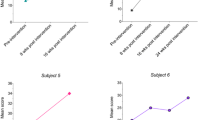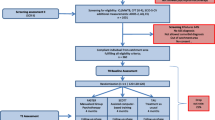Abstract
The study aims to analyze the effectiveness of a swimming program on interpersonal skills, autistic mannerisms, and aquatic abilities in children with autism spectrum disorders (ASD). Research on aquatic therapy showed improvements in motor skills, whereas there is little evidence of effectiveness of this approach on social impairments of ASD. Participants included 25 children, 13 in the experimental group and 12 in the control group, matched for gender, age and autism score. The results showed an advantage in the relational skills for the experimental group at the post-test. The tendency to ameliorate other symptomatology, e.g., autonomy and negative behaviors, persisted at follow-up. Likewise, positive changes in aquatic skills were maintained 6 months after the end of the program.









Similar content being viewed by others
References
Alaniz, M. L., Rosenberg, S. S., Beard, N. R., & Rosario, E. R. (2017). The effectiveness of aquatic group therapy for improving water safety and social interactions in children with autism spectrum disorder: A pilot program. Journal of Autism and Developmental Disorders, 47, 4006–4017. https://doi.org/10.1007/s10803-017-3264-4.
Aleksandrovic, M., Jorgic, B., Block, M., & Jovanovic, L. (2015). The effects of aquatic activities on physical fitness and aquatic skills in children with autism spectrum disorders: A systematic review. Physical Exercise and Sport, 13(3), 351–362.
Attwood, T. (1998). Asperger’s syndrome: A guide for parents and professionals. Philadelphia: Jessica Kingsley.
Bölte, S., Poustka, F., & Constantino, J. N. (2008). Assessing autistic traits: Cross-cultural validation of the social responsiveness scale (SRS). Autism Research, 1, 354–363. https://doi.org/10.1002/aur.49.
Caputo, G., Ippolito, G., Mazzotta, M., Sentenza, L., Muzio, M. R., Salzano, S., et al. (2018). Effectiveness of a multisystem aquatic therapy for children with autism spectrum disorder. Journal of Autism and Developmental Disorders, 48, 1945–1956. https://doi.org/10.1007/s10803-017-3456-y.
Chu, C. H., & Pan, C. H. (2012). The effect of peer- and sibling-assisted aquatic program on interaction behaviors and aquatic skills of children with autism spectrum disorders and their peers/siblings. Research in Autism Spectrum Disorders, 6(3), 1211–1223. https://doi.org/10.1016/j.rasd.2012.02.003.
Clapham, E. D., Armitano, C. N., Lamont, L. S., & Audette, J. G. (2014). The Ocean as a unique t therapeutic environment: Developing a surfing program. Journal of Physical Education, Recreation & Dance, 85(4), 8–14. https://doi.org/10.1080/07303084.2014.884424.
Cole, A. J., & Becker, B. E. (2004). Comprehensive aquatic therapy (2nd ed.). Philadelphia, PA: Butterworth-Heinemann.
Constantino, J. N., Davis, S. A., Todd, R. D., Schindler, M. K., Gross, M. M., Brophy, S. L., et al. (2003). Validation of a brief quantitative measure of autistic traits: Comparison of the social responsiveness scale with the autism diagnostic interview-revised. Journal of Autism and Developmental Disorders, 33(4), 427–433.
Constantino, J. N., & Gruber, C. P. (2005). Social Responsiveness Scale (SRS). Torrance, CA: Western Psychological Services (Italian version: Giunti O.S., Firenze, 2010).
Eaves, R. C., Campbell, O. A., & Chambers, D. L. (2000). Criterion-related and construct validity of the pervasive developmental disorders rating scale and the autism behavior checklist. Psychology in the Schools, 37(4), 311–321. https://doi.org/10.1002/1520-6807(200007)37:4%3c323:AID-PITS2%3e3.0.CO;2-S.
Ennis, E. (2011). The effects of a physical therapy-directed aquatics program on children with autism spectrum disorders. The Journal of Aquatic Physical Therapy, 19(1), 4–10.
Garcia-Pastor, T., Salinero, J. J., Theirs, C. I., & Ruiz Vicente, D. (2019). Obesity status and physical activity level in children and adults with autism spectrum disorders: A pilot study. Journal of Autism and Developmental Disorders, 49(1), 165–172. https://doi.org/10.1007/s10803-018-3692-9.
Huetting, C., & Darden-Melton, B. (2004). Acquisition of aquatic skills by children with autism. Palestra, 20(2), 20–25.
Humphries, K. M. (2008). Humphries’ assessment of aquatic readiness, Unpublished Master’s Thesis, Denton, TX: Texas Woman’s University.
Jansiewicz, E. M., Goldberg, M. C., Newschaffer, C. J., Denckla, M. B., Landa, R., & Mostofsky, S. H. (2006). Motor signs distinguish children with high functioning autism and Asperger’s syndrome from controls. Journal of Autism and Developmental Disorders, 36(5), 613–621. https://doi.org/10.1007/s10803-006-0109-y.
Ketcheson, L., Hauck, J. L., & Ulrich, D. (2018). The levels of physical activity and motor skills in young children with and without autism spectrum disorder, aged 2–5 years. Autism, 22(4), 414–423. https://doi.org/10.1177/1362361316683889.
Krug, D. A., Arick, J. R., & Almond, P. J. (1978). ABC—autism behaviour checklist. Portland, OR: ASIEP Education Co.
Lang, R., Koegel, L. K., Ashbaug, K., Regester, A., Ence, W., & Smith, W. (2010). Physical exercise and individuals with autism spectrum disorders: A systematic review. Research in Autism Spectrum Disorders, 4, 565–576. https://doi.org/10.1016/j.rasd.2010.01.006.
Leopizzi, S., Vicari, P., & Solari, S. (2010). Autismo e acquaticità: esperienze e percorsi educativi (Autism and aquatic therapy: Experiences and educational paths). Trento: Erickson.
Martin, J. (1981). The Halliwick method. Physiotherapy, 67(10), 288–291.
Miranda-Linné, F. M., & Melin, L. (2002). A factor analytic study of the autism behavior checklist. Journal of Autism and Developmental Disorders, 32(3), 181–188. https://doi.org/10.1023/A:1015519413133.
Mortimer, R., Privopoulos, M., & Kumar, S. (2014). The effectiveness of hydrotherapy in the treatment of social and behavioral aspects of children with autism spectrum disorders: A systematic review. Journal of Multidisciplinary Healthcare, 7, 93–104. https://doi.org/10.2147/JMDH.S55345.
Pan, C. Y. (2010). Effects of water exercise swimming program on aquatic skills and social behaviors in children with autism spectrum disorders. Autism, 14(1), 9–28. https://doi.org/10.1177/1362361309339496.
Ratcliff, K., Hong, I., & Hilton, C. (2018). Leisure participation patterns for school age youth with autism spectrum disorders: Findings from the 2016 national survey of children’s health. Journal of Autism and Developmental Disorders, 48(11), 3783–3793. https://doi.org/10.1007/s10803-018-3643-5.
Shiriver, M. D., Allen, K. D., & Matheus, J. R. (1999). Effective assessment of the shared and unique characteristics of children with autism. School Psychology Review, 28(4), 538–558.
Skinner, A., & Thomson, A. (2008). Aquatics therapy and the Halliwick concept. The Exceptional Parent, 38(7), 76–77.
Sorensen, C., & Zarrett, N. (2014). Benefits of physical activity for adolescents with autism spectrum disorders: A comprehensive review. Review Journal of Autism and Developmental Disorders, 1, 344–353. https://doi.org/10.1007/s40489-014-0027-4.
Sowa, M., & Meulenbroek, R. (2012). Effects of physical exercise on autism spectrum disorders: A meta-analysis. Research in Autism Spectrum Disorders, 6(1), 46–57. https://doi.org/10.1016/j.rasd.2011.09.001.
Srinivasan, S. M., Pescatello, L. S., & Bhat, A. N. (2014). Current perspectives on physical activity and exercise recommendations for children and adolescents with autism spectrum disorders. Physical Therapy, 94, 875–889. https://doi.org/10.2522/ptj.20130157.
Sturmey, P., Matson, J. L., & Sevin, J. A. (1992). Analysis of the internal consistency of three autism scales. Journal of Autism and Developmental Disorders, 22(2), 321–328.
Tager-Flusberg, H., Skwerer, D. P., Joseph, R. M., Brukilacchio, B., Decker, J., Eggleston, B., et al. (2016). Conducting research with minimally verbal participants with autism spectrum disorder. Autism, 2(7), 852–861. https://doi.org/10.1177/1362361316654605.
Tirosh, R., Katz-Leurer, M., & Getz, M. D. (2008). Halliwick-based aquatic assessments: Reliability and validity. International Journal of Aquatic Research and Education, 2(3), 224–236. https://doi.org/10.25035/ijare.02.03.04.
Yanardag, M., Akmanoglu, N., & Yilmaz, I. (2013). The effectiveness of video prompting on teaching aquatic play skills for children with autism. Disability and Rehabilitation, 35(1), 47–56.
Yilmaz, I., Yanardag, M., Birkan, B. A., & Bumin, G. (2004). Effects of swimming training on physical fitness and water orientation in autism. Pediatrics International, 46, 624–626. https://doi.org/10.3109/09638288.2012.687030.
Zero to Three Diagnostic Classifications of Mental Health and Developmental Disorders of Infancy and Early Childhood. (1994). https://www.zerotothree.org/resources/services/dc-0-3r.
Zhao, M., & Chen, S. (2018). The effects of structured physical activity program on social interaction and communication for children with autism. BioMed Research International, 107, 1–13. https://doi.org/10.1155/2018/1825046.
Acknowledgments
The authors thank Francesca Ottonelli and Paola Vicari for their contribution to data collection. Moreover, they thank all the schools, the teachers and swimming teachers, the parents, and the students who participated to the research.
Author information
Authors and Affiliations
Contributions
MZ participated in the design of the study, coordinated all the phases of the study, carried out the design and interpretation of the data, and drafted the manuscript; SS participated in the design of the study, participated in the planning of the interventions, performed the measurement, and helped draft some part of the manuscript (namely Methods and Discussion). Both authors read and approved the final manuscript.
Corresponding author
Ethics declarations
Conflict of interest
The authors of this manuscript declare that they have no conflicts of interest.
Ethical Approval
All procedures performed in this study involving human participants were in accordance with the ethical standards of the institutional and national research committee (Ethical Code of Italian Psychology Order and the Ethical guidelines of the Italian Association of Psychology) and with the 2013 Helsinki Declaration.
Informed Consent
Informed consent was obtained from the parents of all children participants included in the study.
Additional information
Publisher's Note
Springer Nature remains neutral with regard to jurisdictional claims in published maps and institutional affiliations.
Rights and permissions
About this article
Cite this article
Zanobini, M., Solari, S. Effectiveness of the Program “Acqua Mediatrice di Comunicazione” (Water as a Mediator of Communication) on Social Skills, Autistic Behaviors and Aquatic Skills in ASD Children. J Autism Dev Disord 49, 4134–4146 (2019). https://doi.org/10.1007/s10803-019-04128-4
Published:
Issue Date:
DOI: https://doi.org/10.1007/s10803-019-04128-4




